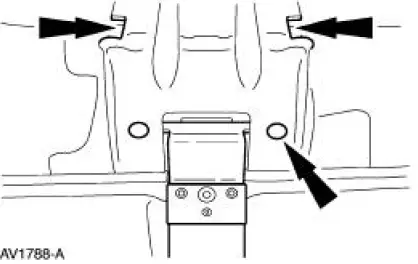Ford Mustang (1999-2004) Service Manual: Support Straps
Removal
WARNING: Do not smoke, carry lighted tobacco or an open flame of any type when working on or near any fuel-related components. Highly flammable mixtures are always present and may be ignited, possibly resulting in personal injury.
WARNING: Fuel supply lines on all vehicles equipped with fuel injected engines will remain pressurized for long periods of time after engine shutdown. Fuel system pressure must be relieved prior to fuel system service to prevent possible personal injury or a fire hazard.
1. Remove the fuel tank. For additional information, refer to Fuel Tank in this section.
2. Slide the strap and the retaining pin into the recess and remove the strap retaining pin.

3. Remove the strap.
Installation
1. To install, reverse the removal procedure.
 Installation
Installation
1. CAUTION: Lubricate the filler pipe check valve area and the
tank-to-filler pipe
grommet with Serfactant prior to assembly or damage to the filler pipe check
valve will
occur.
NOTE: A new grommet ...
 Fuel Pump Module
Fuel Pump Module
Removal and Installation
1. Remove the fuel tank. For additional information, refer to Fuel Tank in
this section.
2. NOTE: For installation, tighten the bolts in the sequence shown.
Remove the modu ...
Other materials:
Countershaft Bearing
Special Tool(s)
Remover, Drive Pinion Bearing
Cone
205-D002 (D79L-4621-A) or
equivalent
Installer, Drive Pinion Bearing
Cone
205-011 (T57L-4621-B)
Disassembly and Assembly
1. Cut the outer cage, then remove the outer cage an ...
Switch
Removal
1. Remove the climate control assembly. For additional information, refer to
Control Assembly in
this section.
2. NOTE: All three switches are removed the same.
Remove the knob.
3. Remove the screw.
4. Rotate the switch and remove it from the cont ...
Turn Signal and Hazard Lamps
Refer to Wiring Diagrams Cell 90 , Turn/Stop/Hazard Lamps for schematic
and connector information.
Special Tool(s)
73 III Automotive Meter
105-R0057 or equivalent
Inspection and Verification
1. Verify the customer concern.
2. Visually ins ...
